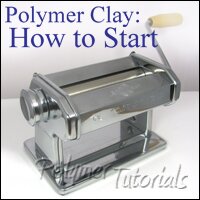How to Start
Working with Polymer Clay
| So, you saw some impressive polymer clay works and would like to try some projects yourself. Where should you begin? Do not run to a craft store (at least, not yet). Although there is quite an impressive list of tools and materials you can acquire for this new hobby, you will not need all of them (not right away, at least). This is good news, isn'st it? Each little gadget does not cost much, but they add up very quickly. To make it easier for your budget, buy only the tools you need at the moment. How do you decide what you need? |
 |
Here are a few of the most common materials and tools that you will most likely find in the project description:
Polymer Clay
Obviously, you will need some polymer clay.
Most project descriptions avoid mentioning specific brands, yet you will find at least a few different types of polymer clay in a craft store and even more on the Internet. So which ones should you buy?
At this point I would recommend Premo. It is easy to find (it is usually available in your local Michael's, Joann Crafts or Hobby Lobby), it will work in any beginner project, it does not require long conditioning, and it is strong enough when baked properly. My second choice would be Fimo (not Fimo Soft, but Fimo Classic). Once you are more comfortable with polymer clay, you may want to switch to Kato polymer clay, as I did. I do not recommend Kato from the very beginning because it is not available in regular craft stores (you have to buy it from specialized PC stores or on-line). It is also stiffer in its raw form and requires more conditioning than other clays. However, Kato is one of the strongest clays when baked, and that is why I like it.
For more information, please refer to my pages about different types of polymer clay and how to choose your polymer clay. You may also want to check my Resources page for a list of places where to buy polymer clay.
Before you go to the store, decide what colors of clay you would like to use for your project. Each 2-oz. block of clay costs about $2.00 (if not on sale). You may have to buy more than one block if multiple colors are required for your project. Keep in mind, however, that different colors of clay may be mixed just as regular paints, so if your project sheet calls for yellow, orange, and red, you can simply buy yellow and red (and mix them to obtain orange). On the other hand, color mixing may be a bit confusing at first, so you may want to get a block of clay of every color mentioned in the project and master color mixing later.
Page 1 of 4



